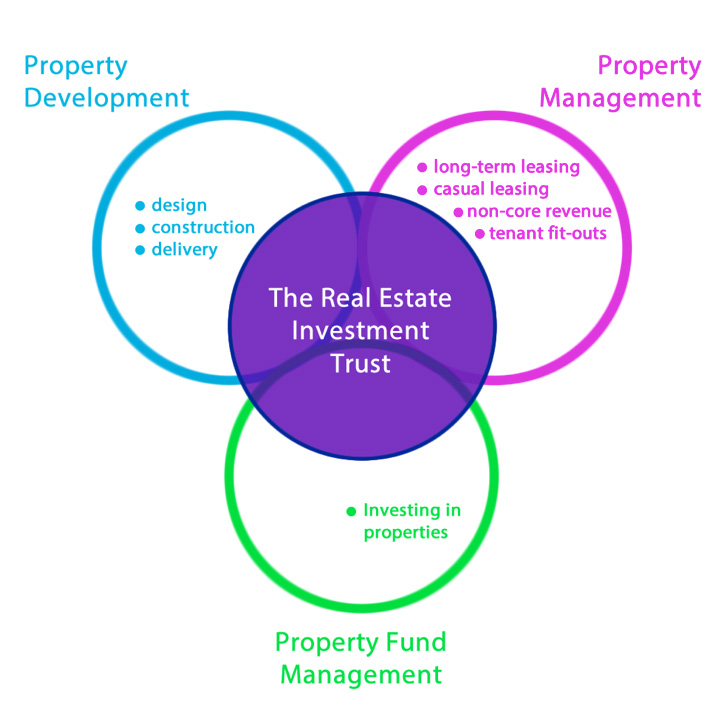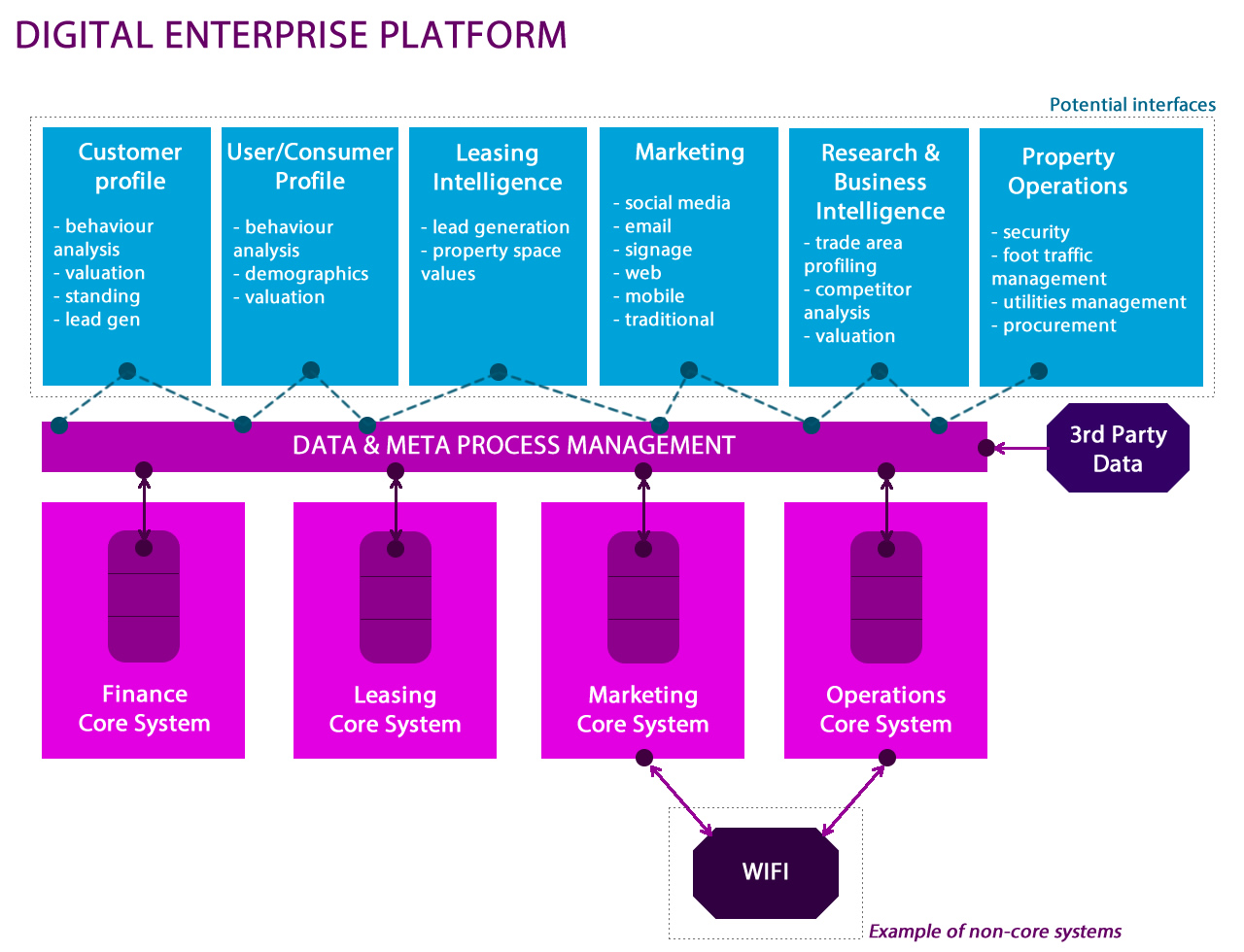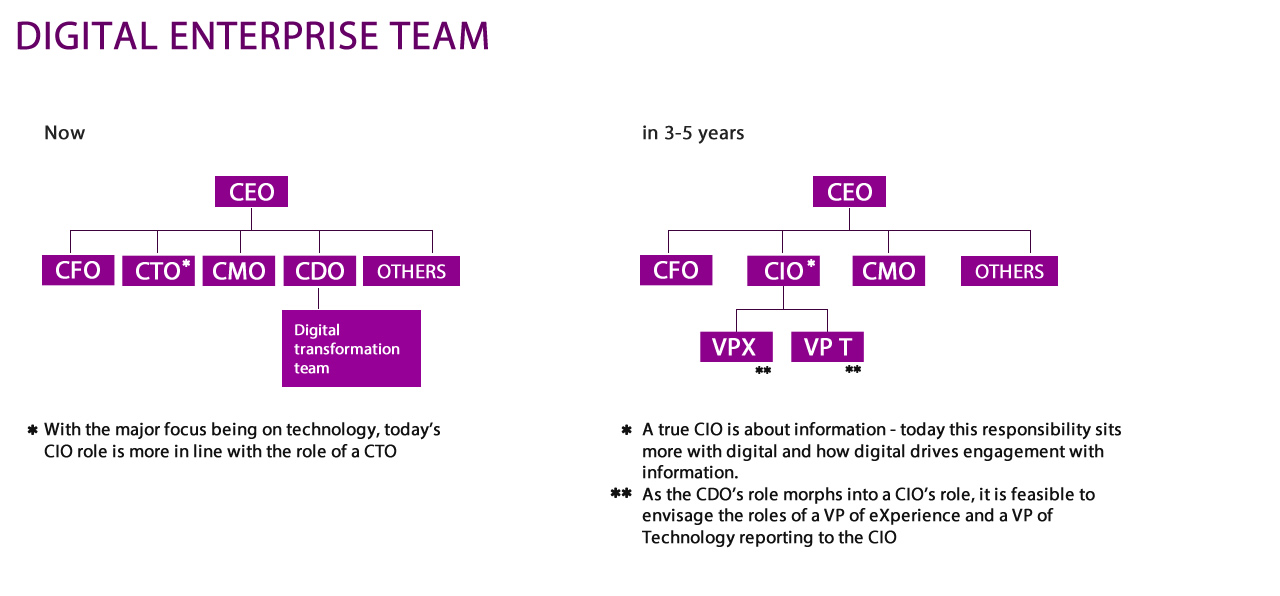Commercial property industry leaders are too reactive when it comes to understanding, managing, embracing, and implementing digital transformation and managing the associated change.
Like many others, the industry tends to look at itself and ponder how digital is transforming its business.
What it seems to lack is an understanding of how digital is changing and disrupting the businesses and industries of its clients – the tenants – and how this will have a significant impact on the commercial property industry – more so than the impact of
More than any other asset class,
As a result of digital disruption in other industry sectors, the old and current business model will be highly disrupted and commercial property groups are far behind other industries in identifying this, preparing for it, and implementing needed changes to build sustainable success in the future.
If we take an oversimplified look at a common current commercial property group model it usually comprises of the following functions and business structure:

In general, much of the business is derived from the management of property assets. The way this business operates will need to change going forward. As it is true for other industries so it is for the commercial property sector: the creation of a truly digital enterprise is vital to future success.
The main issues in managing property assets usually are pretty familiar to any Business 101 undergraduate; reducing costs and increasing revenue.
Traditionally it seems the way these issues have been approached is by either cutting staff, finding new service providers at a more competitive price, to try and derive new revenue from casual leasing and advertising placement, and possibly the largest contributor being to increase rents.
The problem for incumbents is that this model is starting to look unsustainable. Like consumers, tenants are spoilt for choice and information. Property groups will only survive by differentiating themselves through a customer-centric approach that is perceived and recognized as being a true partnership with their tenants, not simply a landlord collecting increasing rents without offering much more than space.
Transforming your business into a digital enterprise is a considerable challenge in the very conservative commercial property sector. It will definitely be part of the solution to address cost reduction (through process changes and process automation) and grow revenue, but first, there will need to be a transformational change in mindset in C-suite and senior-level managers.
THE COMMON SILOS VERSUS THE OMNI-CHANNEL MODEL
Numerous businesses have commonly operated in silos. Leasing does its thing. Purchasing do theirs. Operations another. Nobody shares information, technology, or data.
Recent research by McKinsey & Company has reinforced the need for corporations need to focus on finding their digital sweet spot in order to succeed in the future.
Companies in the commercial property sector need to identify the value of digital for their business. They should understand that in order to discover and extract value from digital they need to abandon a narrow focus of marketing and see that the value of
The ensuing prioritization will be important and will define the expected time frame. Expectations should be managed so that stakeholders understand that digital disruption and change take time and that failure is likely as in any innovative environment.
Embracing failure will determine success as only through failing often, failing fast, and learning from these failures will a business find its path to success and be able to establish an initial digital operations boundary. One must not forget that when dealing with innovation there is no way around failure – it is a good and a natural part of the process of innovation.
Much like in retail or any consumer environment, clients (whether B2B or B2C) expect to receive a seamless experience from end-to-end – and the only way to deliver this is by breaking down silos. Digital supports this objective and is core to any future model by enabling the sharing of data across all business units.
Commercial property companies will need to identify the value of digital for their business, align (and perhaps realign) their business models and objectives accordingly, and invest in digital for the long term, not with a project mindset. Currently though too many treat digital as a project instead of what is really is – a way of doing business.
The ROI of investing in digital in a narrow focus of business process such as marketing will most likely not motivate the seasoned CFO or leadership team. Nor will a business see real value by investing in digital for just one activity. The real payoff is when digital is looked at and implemented across the company.
This is not to say that companies should not focus on one activity at a time but the investment should be made across the business over time in order to maximize ROI.
A POSSIBLE SOLUTION
Clearly understanding and defining your business objectives will help you define and determine the value of digital across your business. Investing carefully will be key. However, to change the corporate mindset, determine value, drive change and digital implementation companies will need an executive who is knowledgeable, experienced and sitting as close to the top of the organization shaping their transition into a digital enterprise.
The chief information officer (CIO) is already a familiar actor on the corporate stage but the role inappropriate for the responsibilities of digital transformation in most commercial property groups.
CIOs were created at the time of the last technology disruption in the mid-1980s. In the Australian property sector, it seems clear that their role is becoming more and more marginalized because they have not evolved.
Instead, their failure to embrace information, and therefore digital, over the last few years as part of their responsibilities has seen CIOs in commercial property really transform more into CTOs (Chief Technology Officers).
This is because historically they have focused their primary attention on systems and technology, and less on information consumption and information usage.
That is still the case today. A true CIO would be a CTO and Chief Digital Officer combined – a rarity indeed.
THE SWITZERLAND OF CDO-SHIP
And so in your transformation phase of embracing digital, you should consider a senior VP of digital or Chief Digital Officer (CDO) to lead digital transformation and implementation across the business. Think of a CDO as Switzerland – they are knowledgeable about technology but also understand the requirements of other business units such as Finance, Marketing, and IT. They are able to translate between each business unit to make sense of the puzzle pieces and deliver digital outcomes that are in line with all business objectives.
And so in your transformation phase of embracing digital, you should consider a senior VP of digital or Chief Digital Officer (CDO) to lead digital transformation and implementation across the business. Think of a CDO as Switzerland – they are knowledgeable about technology but also understand the requirements of other business units such as Finance, Marketing, and IT. They are able to translate between each business unit to make sense of the puzzle pieces and deliver digital outcomes that are in line with all business objectives.
Over the next three to five years this role should report to the CEO, and could ultimately merge into the CIO role. The role of the CDO is to lead digital change and innovation, as well as define the value of digital for the organization– the end goal being the digital enterprise. Through these initial transformation years, they need to be able to centrally manage all digital initiatives across the business, ultimately being accountable for digital.
Managing digital centrally will allow companies to establish and implement the right platform: a layer of meta process modeling driving an information architecture that allows access to all data across the enterprise. This layer of data access can then be repurposed through numerous interfaces for different uses from leasing intelligence to marketing to operations management to a number of other cases and for use by multiple personas.
THE DIGITAL ENTERPRISE
Rome wasn’t built in a day. Neither will your digital enterprise be. Besides mindset and organizational structure changes, your digital team will need to prioritize the areas of focus to start with, while keeping in mind the bigger picture – thinking of integrations and what next business area will be taken through the digital transformation.
You don’t want to build something that only delivers one objective and then realize you need to rebuild everything from scratch when you want to achieve another objective.
Even within the areas being prioritized, you will want to break these down further and always think about the most-viral-product model (MVP). When rebuilding, redesigning, transforming, disrupting and creating change to systems & processes that people are used to, companies should keep it simple. What is the most basic form that will get the most engagement? You can then build from there by listening to the users/stakeholders/customers.
Companies will come to realize that in defining the value of digital for their enterprise that they will need a team to define, develop, design, and implement digital transformation. That team could be a team of 1 or many – defining the value of digital for the business will define the size of the team.
A large part of your transformation will require learning & development programs and training for your existing staff. The digital team should manage this with the appropriate stakeholders and partners and facilitate design- thinking inspired workshops to empathize, define, ideate, prototype, test, and implement digital change across the business, shaping your digital enterprise.
Commercial property leaders will need digital partners to help implement their digital transformation at every stage (working through the prioritization). Don’t be fooled by one-size-fits-all outfits. Companies have specialized in developing best-in-market products & services to handle very specific operations – these should be your core systems.
Start-up products and services should not be ignored either. New providers may have worked out problems and
Due diligence on partners is vital. The obvious: check references. Look and evaluate their past work. Speak to as many of their clients as possible. If they have won awards, have those been recent? If the last time they won an award was 3 or 4 years ago that should tell you something. If they are local – such as a web development team –
The final digital enterprise may look like this:


REDUCING COSTS
Digital transformation will analyze and assist in replacing or refining processes, especially those that are possibly more labour-intensive. This will be achieved through the support of identified software, which will either fully automate the process or assist by improving the individual staff member’s productivity in doing their job.
In the area of research and customer profiling it will reduce costs by gathering data and behavioural information about the customer and the customers’ customers in real-time across a huge sample of the target audiences and non-user audience, making exit surveys and costly third-party surveying redundant. This will provide actionable information, which in the past needed to be collected by surveying customers and potential customers.
This information will be instrumental in increasing conversions.
In marketing, more engaging and contextually hyper-relevant communication channels can be created or taken advantage off. These can be highly measurable, therefore reducing the waste of marketing dollars spent on more traditional almost immeasurable mediums. Even if something is free but not returning any data this is a cost to your business – the lack of information is a cost against your enterprise.
In operations,
Many more opportunities for cost reduction across the enterprise are feasible. Overall, studies such as McKinsey & Company’s yearlong study on the impact of digital on enterprises (summarized in their paper ‘Finding your digital sweet spot’) shows that cost reductions through digital transformation can amount to an average of 36 per cent.
Reducing costs is probably the easier part of the equation. Increasing revenue will require a change in business model. The following are strategies for this change:
Changing your property asset management model
The model is broken. Property groups, as much as they are currently trying, are still perceived as landlords and not partners. This is probably due to their attachment to rental income and their anchored-in-stone mindset about the use of their space.
The traditional space usage offered in commercial property is no longer enough for tenants and users of the premises, whether they are shoppers or workers.
There is an ongoing demand and need for commercial property space to become more experiential while also transforming its functionality, especially in the retail and office sectors of commercial property. One doesn’t need to look far at highly successful examples being created by the likes of Google, or Facebook, or even Apple’s new campus building. Google’s new office
building in London is a prime example of experiential space in the office sector.
And this is far more than being left to the fit out of space. This starts with the property owner and manager.
In office buildings, especially, were we spend a considerable part of our lives surrounded by people we spend most of our lives with, it’s even more important that
The majority of people come to work because it pays the bills and
Beyond improving the use of physical space in commercial property, property owners and managers need to reduce their reliance on rent. Upholding such importance on rental revenue is dangerous. Managers want salary increases and bonuses, and in tough economic times, more capital is needed. Relying on rents to such an extent only leads to rental increases and/or rent
To offset the reliance on rental revenue, especially long-term rents, property owners and managers should focus on:
- Casual leasing playing a bigger part of the revenue mix.
- Investing in and offering a range of services to tenants – almost like a menu of services clients to select.
These will only be financially feasible by understanding your clients’ businesses and industries, working as a partner to offer services that are valuable to your clients’ business success. Today’s wider digital disruption means that location is no longer the predominant competitive differentiator. Property owners & managers need to be able to answer compellingly in the digital age the reasons why a client would want to rent from them versus a competing property owner?
As a potential tenant, you would want to know a lot more about the property, how other tenants have found renting there, what services the property owner can offer you in order for you to run your business successfully from that location. In retail, you would want to know how well the property managers know their trade area and whether or not they are marketing appropriately to your target audience. After all, they are promising you to bring more foot traffic through your doors.
Customer service is one thing – being nicer than the other guy has always gone a long way – but today’s value proposition in commercial property whether in retail, office, logistics, or business parks is no longer valid to drive a sustainable business in the future.
In retail commercial property, the value proposition is about driving foot traffic into a shopping centre in order for the tenant (retailer) to convert more people and therefore increase retail sales. There are numerous ways a property manager achieves this including retail mix and trade area marketing.
Using outdated information about shoppers, their habits, their desires (the majority of purchases are emotional, not rational), their demographics (income, marital status, living situation, age, gender, postcode), shopping centre managers still predominantly use traditional marketing initiatives to drive into the mall who they think is their target audience.
Through digital change, they could instead analyze shopper behaviour both online and in the physical space, create a rich profile of individual shoppers including a deep understanding of the trade area and where their clients’ (retailers) clients (shoppers) reside specifically. They could create a breakdown by shopper value of the entire trade area and target on a one-to-one basis with the individual shopper their marketing communications.
Retail property managers need to work closely with their tenants (yes in some cases this means over 300 retailers in one particular mall) to understand their business and how they can support their tenants business. By doing so they will be able to implement a number of services that the tenant needs and sell this service to their clients, thereby creating new sources of revenue.
Providing these services for a fee is really about understanding each retailer’s needs to succeed.
Some of these services may include:
- Education and L&D for staff and the management of these retailing tenants. For example, helping retailers understand the benefits of omnichannel retailing and how the property owner can help the retailers achieve
- Omni-channel retail support:
- Allowing for flexible usage of the retail space, dividing it up into front showroom space and back office mini distribution hub, accommodating click & pick up orders.
- Creating a central space in the shopping centre to facilitate click & pick up orders for smaller retailer or retailers who are not able to reconfigure their space.
- Facilitating and creating new online sales channels for 2nd and 3rd tier retailers.
- Facilitating logistics:
- Providing warehousing, order management, inventory management, and shipping management.
- Providing delivery services (vans, cars, rickshaws, scooters, bikes, drones) and delivery service options such as lockers accessible by shoppers outside of trading hours.
Instead of fighting against showrooming and e-commerce, property owners & managers should be embracing it by helping their clients succeed in an omnichannel environment, which has proven to be far more beneficial to the retailer than traditional single or even multi-channel retailing.
In the office space sector, by working closely with tenants and understanding their business needs, property managers could offer needed services at competitive prices through economies of scale by matching tenants with others or buying utilities wholesale and reselling them to tenants. Thinking of an office building much like a vibrant community, using some of the hospitality industry’s best practices, and looking at replicating the success of companies’ own offices such as Google’s, on the scale of an office building, office property managers will be able to create new chargeable service opportunities.
In logistics, the ability to offer automated warehousing infrastructures (such as the Coca Cola Amatil automated warehouse in Northmead – Sydney) could be a chargeable service or converting logistics warehousing space into data centres could be another opportunity. Working with retail tenants to cross sell warehousing (including OMS and IMS) should be a no brainer.
Across all asset classes, marketing departments could include offering marketing services to tenants such as:
- Creative services
- Branded content opportunities (events and experiential initiatives)
- Experiential marketing initiatives
- Social media branded opportunities
- Social media experiential opportunities
- Social media e-commerce opportunities
- Advertising opportunities
Technology and utility services (telecommunications) too should be services that property owners offer to tenants at competitive prices, hence creating new revenue sources.
POWERING THE FUTURE
Digital will power the future of
For example, over 50 per cent of air travel is now purchased online. Had a property group like The GPT Group identified this trend they could have taken advantage of supplying their travel tenants in their retail properties, such as Flight Centre, with additional space in their office properties, and possibly even offered additional services for their travel retailing clients to succeed online, such as hosting and data warehousing. Instead, all retail commercial property owners have likely experienced a decline in space rented by travel agents – thus losing revenue.
SOME KEY TAKEOUTS
- Digital transformation will need to align with business objectives and business objectives will need to align with digital value.
- Digital transformation will facilitate and only be truly valuable if silos are broken down and data is shared across all business units in the most efficient and effective way.
- Digital transformation will enable business intelligence, resulting in cost reductions and opportunities to increase revenue across all property asset classes.
Initially, companies need executive leadership at the highest level of the organization to drive digital transformation. This role is about defining the value of digital for the business and as a result building the appropriate resources (internal + external). It is about working closely with all business units and especially IT to put in place the right platform while thinking of future development and integration of multiple services and data sources.
With this in place, the value of digital can be exponential and lead to further innovation and the delivery of smarter customer & user experiences not only in marketing but also operations, leasing, and management. Operating like a start-up within the corporation, this executive and their team should be driving and managing digital change and innovation initiatives centrally to be able to maintain a holistic and strategically sustainable digital enterprise over time.
The future of digital is simply business-as-usual: current staff will morph into digital savvy executives through L&D and training programs. Digital will simply disappear in the background. It will become an aspect of I.T. And future innovation initiatives will take its place – these may even be managed by a digital or ‘experience team’ within the remit of the CIO and working across the enterprise.
The current asset management model in commercial property is simply not sustainable for future success.

